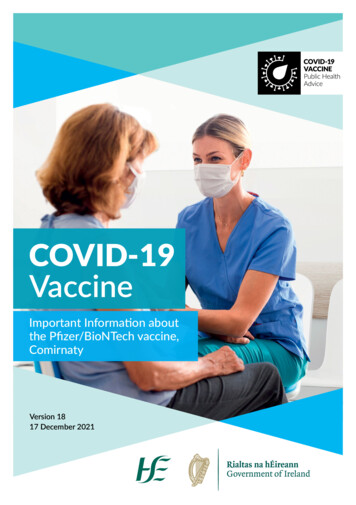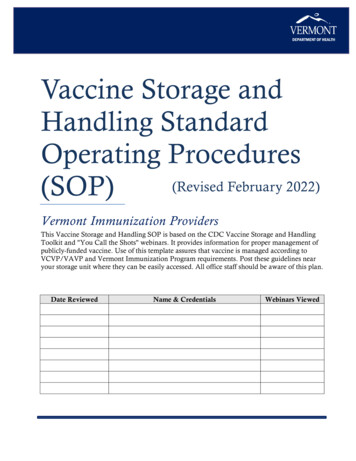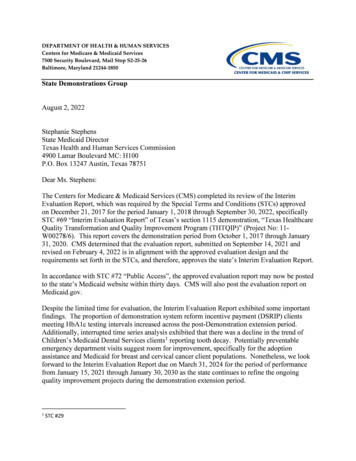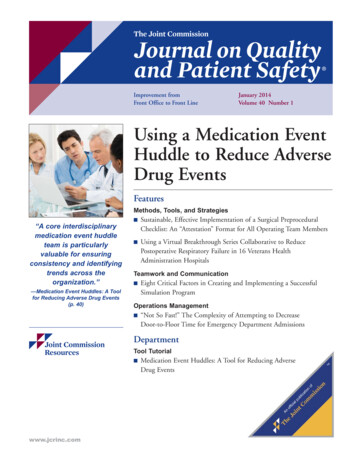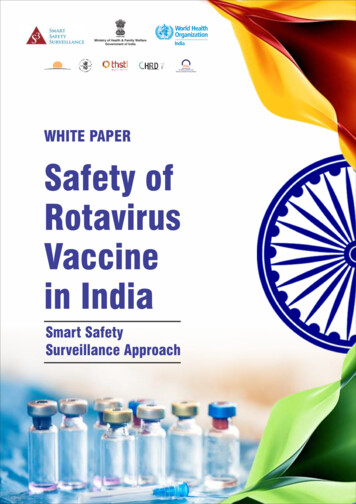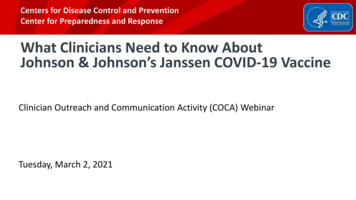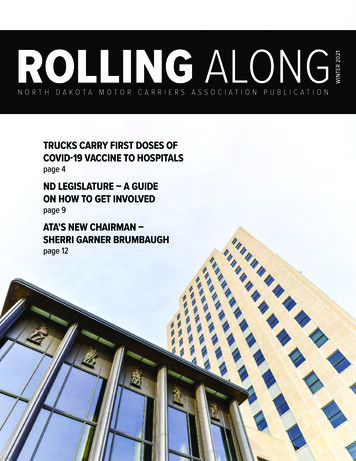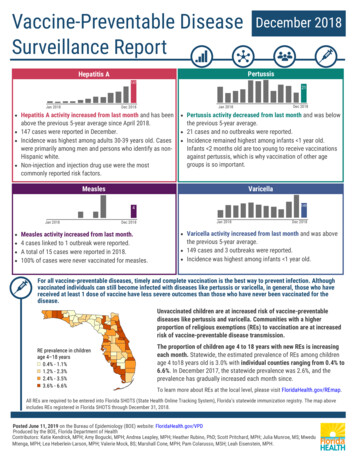
Transcription
Vaccine-Preventable DiseaseSurveillance ReportDecember 2018PertussisHepatitis A147Jan 201821Dec 2018Jan 2018Dec 2018 Hepatitis A activity increased from last month and has been Pertussis activity decreased from last month and was belowabove the previous 5-year average since April 2018. 147 cases were reported in December. Incidence was highest among adults 30-39 years old. Caseswere primarily among men and persons who identify as nonHispanic white. Non-injection and injection drug use were the mostcommonly reported risk factors.the previous 5-year average. 21 cases and no outbreaks were reported. Incidence remained highest among infants 1 year old.Infants 2 months old are too young to receive vaccinationsagainst pertussis, which is why vaccination of other agegroups is so important.MeaslesVaricella1491494Jan 2018Dec 2018 Measles activity increased from last month. 4 cases linked to 1 outbreak were reported. A total of 15 cases were reported in 2018. 100% of cases were never vaccinated for measles.Jan 2018Dec 2018 Varicella activity increased from last month and was abovethe previous 5-year average. 149 cases and 3 outbreaks were reported. Incidence was highest among infants 1 year old.For all vaccine-preventable diseases, timely and complete vaccination is the best way to prevent infection. Althoughvaccinated individuals can still become infected with diseases like pertussis or varicella, in general, those who havereceived at least 1 dose of vaccine have less severe outcomes than those who have never been vaccinated for thedisease.Unvaccinated children are at increased risk of vaccine-preventablediseases like pertussis and varicella. Communities with a higherproportion of religious exemptions (REs) to vaccination are at increasedrisk of vaccine-preventable disease transmission.The proportion of children age 4 to 18 years with new REs is increasingeach month. Statewide, the estimated prevalence of REs among childrenage 4 to18 years old is 3.0% with individual counties ranging from 0.4% to6.6%. In December 2017, the statewide prevalence was 2.6%, and theprevalence has gradually increased each month since.To learn more about REs at the local level, please visit FloridaHealth.gov/REmap.All REs are required to be entered into Florida SHOTS (State Health Online Tracking System), Florida’s statewide immunization registry. The map aboveincludes REs registered in Florida SHOTS through December 31, 2018.Posted June 11, 2019 on the Bureau of Epidemiology (BOE) website: FloridaHealth.gov/VPDProduced by the BOE, Florida Department of HealthContributors: Katie Kendrick, MPH; Amy Bogucki, MPH; Andrea Leapley, MPH; Heather Rubino, PhD; Scott Pritchard, MPH; Julia Munroe, MS; MweduMtenga, MPH; Lea Heberlein-Larson, MPH; Valerie Mock, BS; Marshall Cone, MPH; Pam Colarusso, MSH; Leah Eisenstein, MPH.
Hepatitis A SurveillanceDecember 20182018 Key PointsMap 3559cases30-39 year olds hadhighest incidence14% cases linkedto other casesThe number of reported hepatitis A cases steadilyincreased each month since April 2018 and has remained ator above the previous 5-year-average all year. The numberof cases reported in December increased from the previousmonth and was the highest reported in 2018.The 147 hepatitis A cases in December were reportedin the 22 counties outlined in black. The centralFlorida region had the highest hepatitis A activitylevels in 2018. In 2018, 96% of cases have likely beenacquired locally in Florida.147140120201810099858060524020022% co-infected withhepatitis B or C81512141426Jan Feb Mar Apr May Jun3651Previous 5-yearaverageJul Aug Sep Oct Nov DecFrom January 1, 2018 through December 31, 2018, 559hepatitis A cases were reported in 31 counties.The number of reported hepatitis A cases more thandoubled from 2016 to 2017 after remaining relativelystable in previous years. Case counts in 2018 haveexceeded those seen in previous years and are more thandouble the case counts in the last 5 years.97%never 18The best way to prevent hepatitis A infection is through vaccination. In 2018, 97% of people withhepatitis A had never received a documented dose of hepatitis A vaccine. In December, 95% ofinfected people had not received the vaccine. Hepatitis A vaccine is recommended for all childrenat age 1 year and for certain high-risk groups of adults including illegal drug users and men whohave sex with men. To learn more about the hepatitis A vaccine, talk to your doctor or Hep-A.html.
HepatitisA SurveillanceVaricellaSurveillanceDecember 2018Epi linked cases Total casesIn 2018, 79 (14%) of 559 total cases of hepatitis Awere epidemiologically (epi) linked to other cases. InDecember, 12% of cases were linked to other cases.Dec14717In December 72% of relationships were householdcontact and 28% sexual contact.201879559In 2018, the incidence rate was highest among adults aged 30-39 years old at 7.1 cases per 100,000 population. InDecember, the incidence rate was highest among adults aged 30-39 years old at 1.9 cases per 100,000 population. In2018, cases were reported primarily among men (67%) and persons who identify as non-Hispanic white (74%). 18 years0.219-29 years3.730-39 years7.140-49 years4.950-59 years2.8 60 years0.9In 2018, 6 (1%) cases were co-infected with chronic hepatitis B, 108 (19%) cases were co-infected with chronic hepatitisC, and 10 (2%) cases were co-infected with both chronic hepatitis B and C. In December, 21% of cases were co-infectedwith chronic hepatitis B or C. Co-infection with more than 1 type of viral hepatitis can lead to more severe liver disease andincrease the risk of developing liver cancer.Chronic hepatitis B Chronic hepatitis C Chronic hepatitis B and C No co-infection1%19%2%78%National activityHepatitis A rates have decreased by more than 95% since the first vaccine became available in 1995. However, sinceMarch of 2017, the Centers for Disease Control and Prevention has been monitoring outbreaks in 15 states amongpersons who use drugs and persons who are homeless. Kentucky and West Virginia have been the most heavilyimpacted, and response efforts are ongoing. More information about these outbreaks can be found atitisA.htmHepatitis A surveillance goals Identify and control outbreaks and monitor trends Identify and mitigate common sources Monitor effectiveness of immunization programs and vaccinesTo learn more about hepatitis A, please visit FloridaHealth.gov/HepA. For more information on the data sources used in Florida forhepatitis A surveillance, see the last page of this report.
HepatitisA SurveillanceVaricellaSurveillanceDecember 2018Statewide Response to the Increase in Hepatitis A CasesSeveral Florida counties have experienced ongoing local transmission of hepatitis A since 2017. Since January 2018, 96% ofFlorida’s cases (n 534) have likely been acquired in Florida. Cases likely acquired in Florida share several common risk factorsincluding drug use (both injection and non-injection drugs), identifying as men who have sex with men, and recently experiencinghomelessness. Individuals with any of these risk factors should receive the hepatitis A vaccine, and providers are encouraged toactively offer the hepatitis A vaccine to individuals at risk. Vaccination is the best way to prevent hepatitis A infection.For additional information, please see the health advisory issued by the Florida Department of Health in November 2018, availableat: bout-us/sunshine-info/advisories/ ll-accepted-eo-format-final.pdf.!Over half (57%) of the 534 cases likely acquired in Florida reported at least one of the risk factors below, while 43%reported no or unknown risk factors. The most commonly identified risk factor was drug use, reported by 263 (49%)cases. Injection drug use was just as common a risk factor as non-injection drug use. Homelessness, reported by 13% ofcases, was also a common risk factor.Any drug use49%Injection drug use32%Non-injection drug use32%Recent homelessness13%Men who have sex with men11%Hepatitis A infections can be severe, leading to inpatient hospitalization and sometimes death. In 2018, 386 (72%) caseslikely acquired in Florida have been hospitalized because of their hepatitis A infection, and there were 2 hepatitis Aassociated deaths identified.72%2hospitalizeddeathsThe Florida Department of Health is actively working to vaccinate those most at risk for hepatitis A infection. In recentmonths, the number of first doses of hepatitis A vaccine administered by both private providers and county healthdepartments to adults age 18 years and older, as recorded in Florida SHOTS, increased. Vaccination is the best way toprevent hepatitis A infection.Previous 5-year Dec
Pertussis SurveillanceDecember 2018December Key Points21cases0outbreaksAverage of 4contacts per caseThe number of pertussis cases reported in Decemberdecreased from the previous month and was below theprevious 5-year average. In general, more pertussis cases arereported during the summer months.52% cases not upto-date or unknownvaccination status 1 year olds hadhighest incidenceThe 21 pertussis cases in December were reportedamong the 10 counties outlined in black. During theprevious 3 months (October through December), theaverage county rate has varied throughout the state.70Previous 5-year n Feb Mar Apr May Jun Jul Aug Sep Oct Nov DecFrom January 1, 2018 through December 31, 2018, 331pertussis cases were reported in 35 counties.735Since 2014, the number of pertussis cases reportedannually decreased. Pertussis is cyclic in nature with peaksin disease every 3-5 years. Pertussis cases last peakedbetween 2013 and 2014. In 2018, case counts remainedconsistent with those seen during non-peak years.In December, 2 (10%) of 21 total pertussis cases were associatedwith transmission within households and no cases were outbreakassociated. For most pertussis cases, exposure to other knowncases is never identified, and they are not able to be linked tooutbreaks.Household-associated Outbreak-associated Total casesDecPrev 3Mo 172018No new pertussis outbreaks were reported inDecember.Eight pertussis outbreaks have been reported in2018. Outbreak settings include schools (4outbreaks), daycares (2 outbreaks), workplace(1 outbreak), and extended family (1 outbreak).
Pertussis SurveillanceDecember 2018For each pertussis case reported in December, there was an average of 4 contacts for whom antibiotics wererecommended to prevent illness. For those diagnosed with pertussis, antibiotics can shorten the amount of time they arecontagious to others. Antibiotics can also be used to prevent illness in those who have been exposed to someone withpertussis while they are contagious.21cases56contactsIn December, the rate of pertussis was highest among infants 1 year old at 1.3 cases per 100,000 population, which isconsistent with previous months. Infants experience the greatest burden of pertussis infections, not only in number ofcases but also in severity. Infants 2 months old are too young to receive vaccinations against pertussis, which is whyvaccination of parents, siblings, grandparents, and other age groups is so important to help prevent infection in infants. 1 year1.31-5 years0.96-11 years0.112-18 years19 years0.30.1Vaccination is the best way to prevent pertussis infections. In December, more than half of individuals reported withpertussis had not received the recommended number of pertussis vaccinations for their age or had unknown vaccinationstatus. Vaccination against pertussis is important for everyone including infants, children, teenagers, and adults.Pregnant women should get vaccinated during the third trimester of each pregnancy to protect their babies. See the lastpage of this report for links to vaccination schedules recommended by the Centers for Disease Control and Prevention.Never vaccinated Under vaccinated Too young for vaccinations Up-to-date on vaccinations Unknown vaccination status24%14%10%38%14%
Pertussis SurveillanceDecember 2018In 2018, over half of infants and children aged 6 months to 5 years with pertussis were not up-to-date on their pertussisvaccinations. In general, those who have received at least 1 pertussis vaccination have less severe outcomes than thosewho have never been vaccinated.Never vaccinated Under vaccinated Too young for vaccinations Up-to-date on vaccinations Unknown vaccination status0-1 months2-3 months4-5 months22717426-17 months1418 months-5 years6-11 years12-18 years19 years532712513912132521111712551555National activityThe number of pertussis cases gradually increased since the 1980s, peaking in 2012 at levels not seen since the 1950s.Since 2012, the number of pertussis cases started gradually decreasing. Pertussis incidence has remained highest amonginfants 1 year old and lowest among adults 20 years old since the 1990s.Pertussis surveillance goals Identify cases to limit transmission in settings with infants or others who may transmit pertussis to infants Identify and prevent outbreaks Identify contacts of cases and recommend appropriate prevention measures, including exclusion, antibiotic prophylaxis, andimmunization Monitor the effectiveness of immunization programs and vaccinesTo learn more about pertussis, please visit FloridaHealth.gov/Pertussis. For more information on the data sources used in Floridafor pertussis surveillance, see the last page of this report.
Measles SurveillanceDecember 2018December Key PointsMap 34cases1outbreak100% cases neverimmunized15In 2018, 15 measles cases werereported in 4 counties. Fewer than 10cases were reported each year from2010 to 2017.8In 2018, a total of 15 Florida residentsand 4 visitors with measles have spenttime in Florida while infectious.1201002011Outbreak-associated Total In December, all 4 reported cases were associatedwith an outbreak in Sarasota County. Heightenedresponse during measles investigations helps toconnect cases.There were two outbreaks reported in 2018,representing 11 of the 15 cases that were reported.Vaccination is the best way to prevent measles infections.In December, all 4 cases were unvaccinated for measles.Due to generally high vaccination rates, measles in Florida is rare butoccurs every year and is most often associated with international travel.So far, no international travel has been identified among the cases.100%Never vaccinatedNational and International activityEven though measles has been eliminated in the United States since 2000, cases occur every year, mostly amongunvaccinated individuals. As of December 1, 292 confirmed cases of measles have been reported by 26 states and theDistrict of Columbia in 2018. The 2-dose measles vaccination schedule has been successful at decreasing cases.Recently, increased measles activity has been reported all over the world. The Centers for Disease Control andPrevention (CDC) issued a Level 1 Travel Alert for several countries with measles outbreaks. Travelers to thesecountries should make sure they are vaccinated against measles with the MMR (measles, mumps, and rubella) vaccine.For more information, please visit wwwnc.cdc.gov/travel/notices.Measles surveillance goals Prevent transmission and severe disease Initiate control measures Monitor effectiveness of immunization programs and vaccinesTo learn more about measles, please visit FloridaHealth.gov/Measles. For more information on the data sources used inFlorida for measles surveillance, see the last page of this report.
Varicella SurveillanceDecember 2018December Key Points149casesMap3 showsthe previous three-month average ofMap3varicella incidence rates per 70%100,000population,casesnot up-April 1 year olds hadthrough June 2018 (green shading).Countieswith one orto-date or unknownhighest incidencemore cases reported in July 2018arehighlightedvaccination statusin pink.3outbreaksThe number of varicella cases reported in Decemberincreased from last month and was above the previous 5-yearaverage. In general, more varicella cases are reported duringthe late winter and summer months.160The 149 varicella cases in December were reportedamong the 27 counties outlined in black. During theprevious 3 months (October through December), theaverage county rate varied throughout the 48Previous 5-year average0Jan Feb Mar Apr May Jun Jul Aug Sep Oct Nov DecFrom January 1, 2018 through December 31, 2018, 905varicella cases were reported in 52 counties.The annual number of reported varicella cases decreasedfrom 2015 to 2017. Thus far in 2018, case counts are notablyabove the total number of cases in previous years.In December, 16 (11%) of 149 total cases were associated withtransmission within households and 18 (12%) cases wereoutbreak-associated. For most varicella cases, exposure toother known cases is never identified, and they are not able to belinked to outbreaks.Household-associated Outbreak-associated Total casesDecPrev 3Mo AvgSep-Nov1612 Three varicella outbreaks were reported inDecember. Two were reported in schools inPinellas County (8 cases to date) and ColumbiaCounty (5 cases to date). One was reported in adaycare in Hillsborough County (11 cases todate). Individuals were identified in November andDecember for all three outbreaks reported thismonth.11 total varicella outbreaks were reported in 2018,of which 6 occurred in schools, 1 in a daycare,and 4 in correctional facilities. The majority ofoutbreaks in schools have occurred inpopulations with high religious exemption rates.
Varicella SurveillanceDecember 2018In December, the varicella rate was highest amonginfants 1 year old at 3.9 cases per 100,000population, which is consistent with previous months.Infants 1 year old are too young to receive varicellavaccination, which is why vaccination of siblings,parents, grandparents, and other age groups is soimportant to help prevent infection in infants. 1 year3.91-5 years1.06-11 years0.812-18 years0.319 years 0.1Vaccination is the best way to prevent varicella infections. In December, over half of individuals reported with varicellahad not received the recommended number of varicella vaccinations for their age or had unknown vaccination status.Vaccination against varicella is important for infants, children, teenagers, and adults. See the last page of this report forlinks to the Center for Disease Control and Prevention (CDC) recommended vaccination schedules.Never vaccinated Under vaccinated Too young for vaccinations Up-to-date on vaccinations Unknown vaccination status17%2%10%20%51%In 2018, 42% of children aged 15 months to 5 years with varicella were not up-to-date on their varicella vaccinations.Although individuals who have been vaccinated can still get varicella, complete and timely vaccination remains the bestway to prevent varicella and severe complications.0-11 months12-14 months801015 months-5 years2696-11 years12-18 years171165971319 years852130511613151510195National activityVaricella incidence decreased significantly following the vaccine becoming available in 1995 and has continued todecrease since 2006 when recommendations changed from 1 to 2 doses of varicella vaccine. From 2006 to 2015, allage groups had a substantial decrease in incidence with the largest decline in children aged 5 to 14 years. Althoughvaricella is not reported to the CDC by all states, based on available data, the number of varicella cases nationally hassteadily decreased each year from 2012 to 2015.Varicella surveillance goals Identify and control outbreaks and monitor trends and severe outcomes Monitor effectiveness of immunization programs and vaccinesTo learn more about varicella, please visit FloridaHealth.gov/Varicella. For more information on the data sources used in Florida forvaricella surveillance, see the last page of this report.
Vaccine-Preventable Diseases Surveillance System SummaryCase Data Current case data are preliminary and will change as new information is gathered. The most recent data available are displayed inthis report. Pertussis, varicella, hepatitis A, and measles are reportable diseases in Florida. Case information is documented by county healthdepartment (CHD) epidemiologists in Merlin, Florida’s reportable disease surveillance system. Only Florida residents are included in case counts, but contact investigations are conducted for all exposed individuals. Pertussis, varicella, hepatitis A, and measles case counts include both confirmed and probable cases. Map counts and rates are determined by the individual’s county of residence; these data do not take into account location ofexposure. CHD epidemiologists also report outbreaks of pertussis, varicella, and hepatitis A into Merlin. Household-associated cases are defined as 2 cases exposed within the same household. Pertussis and mumps outbreaks are defined as 2 cases associated with a specific setting outside of a household. Varicella outbreaks are defined as 5 cases associated with a specific setting outside of a household. Measles outbreaks are defined as any person acquiring measles while in Florida. For more information about reportable diseases, please visit FloridaHealth.gov/DiseaseReporting. For more information about Florida’s guides to surveillance and investigation, including disease-specific surveillance casedefinitions, please visit FloridaHealth.gov/GSI.Population Data Population data used to calculate incidence rates are from FLHealthCHARTS (Community Health Assessment Resource ToolSet). For more information about FLHealthCHARTS, please visit FLHealthCharts.com.Vaccination Data Vaccination data for identified cases are from Merlin, as documented by CHD staff. Vaccination status is determined using the Advisory Committee on Immunization Practices Recommended ImmunizationSchedule for Children and Adolescents Aged 18 Years or Younger, 2018. For more information about immunization schedules, please visit www.CDC.gov/Vaccines/Schedules/index.html. Individuals are considered up-to-date on vaccinations if they have received the recommended number of doses of vaccine for aparticular disease for their age at the time of their illness onset. Individuals are considered under-vaccinated if they have receivedat least one but not all doses of vaccine recommended for a particular disease for their age at the time of their illness onset. For a full text version of a new study on pertussis vaccination, please visit sis-Resurgence.
Monitor effectiveness of immunization programs and vaccines . To learn more about hepatitis A, please visit FloridaHealth.gov/HepA. For more information on the data sources used in Florida for hepatitis A surveillance, see the last page of this report. 559 147 79 17 2018 Dec. In 2018,79 (14%)of559 total casesof hepatitis A
